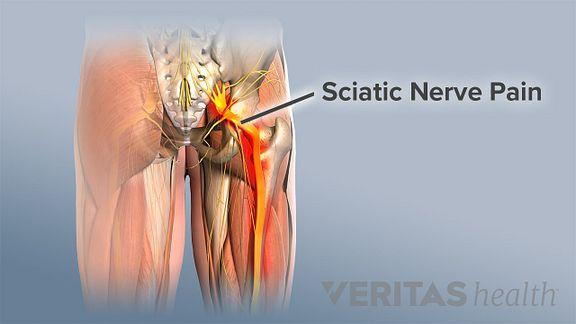
- updated: Apr. 14, 2022
- Neck Pain, Sleeping Tips, Spine Health
Massage therapy provides a promising way to help ease your sciatica pain1 through a combination of:
- Relaxing tight muscles
- Improving blood circulation2
- Reducing stress2
- Fostering a better healing environment2
Massage therapy is a commonly overlooked treatment for sciatic pain.
Learn more: Sciatica Treatment
The specific benefits of massage on the tissues of your lower back, guidance on finding a good massage therapist, and simple tips for self-administered massages are highlighted below.
The effects of massage on nerves and soft tissues
Depending on the type of massage, a therapist may work on your muscles, joints, nerves, and/or layers of connective tissue deep below your skin. A few examples of massage techniques include deep tissue massage, trigger-point therapy, and neuromuscular therapy.2
A massage can cause the following changes to occur in your body, easing the sciatica pain:
- Loosen and relax muscles. When your trunk, core, and lower back muscles are tight, they can apply pressure on the sciatic nerve root(s) in your lower back. Tight muscles may also get knotted up into small painful nodules, causing trigger point pain. Massage therapy can effectively stretch, loosen, and elongate these muscles, improving pain and function in your lower back and legs.2
- Facilitate the circulation of healing nutrients. Hands-on soft tissue manipulation from massage stimulates the blood vessels in your skin and deeper tissues. There is enhanced circulation of blood, oxygen, and other nutrients to the sore areas, promoting healing.2
- Release endorphins. Massage stimulates specific pressure receptors in your brain, which are special nerve fibers. Stimulation of these pressure receptors helps reduce pain by releasing endorphins, the body’s natural feel-good hormone.2,3
- Reduce stress. Stimulation of the pressure receptors also helps reduce the levels of cortisol in your body—the hormone that causes stress. Reduced stress helps provide a feeling of relaxation and relief, with a lesser perception of pain.2,3
Some therapists may use aromatic oils or essential oils to rub into your skin. Some of these oils may have a therapeutic effect on tissues and help reduce pain. The scent from these oils also helps provide an overall relaxed feeling. If certain types of scents bother you, inform your therapist before you start the massage.
Massages are usually safe when performed by a trained professional. Rarely, increased pain, soreness, stiffness, and/or damage to blood vessels and/or nerves may occur from the forceful application of pressure.2
Read more about Massage Therapy for Lower Back Pain
Finding the right massage therapist
Therapeutic massages are typically given by qualified, trained professionals, such as massage therapists, physical therapists, sports medicine professionals, occupational therapists, and other qualified health practitioners. You can enjoy a relaxation massage at a spa or a massage center. Massages can also be self-administered.
Here are a few pointers to help you identify the right type of massage technique and therapist for your sciatica pain:
- Identify your goals. Figure out what you want to accomplish before you start your search for a massage therapist. For example, if you want to relieve lower back tension, look for someone who is trained in specific muscle-relaxation techniques, such as neuromuscular therapy. If your goal is simply to raise your endorphin levels, you can head to your local spa for a basic Swedish (deep tissue) massage.
- Consult with your doctor. Your doctor may be able to recommend an appropriately qualified health professional who administers therapeutic massage in your area. If you have specific health conditions, such as high blood pressure or nerve problems (neuropathy) in your leg, a doctor can advise if massage is a safe option to consider for your sciatica pain.
- Check with professional organizations. The American Massage Therapy Association provides a searchable list of licensed massage therapists in your area. The list is not exhaustive, but unlike internet search engines, it screens out individuals who are not legally allowed to practice.
For people who have difficulty with mobility or driving, consider an in-home massage in which the therapist will come to your home.
See Massage Therapy Considerations for Lower Back Pain
DIY Massage
You can also massage your back using tennis balls and topical medication or creams. A few simple tips include:
- Secure two tennis balls next to each other with duct tape. Place the secured balls under your back, buttock, or upper thigh while you lie on the floor and gently move around to find sore muscle groups. When you identify a tender spot, focus and press the area gently.
- Press a tennis ball between your chair and lower back to loosen up tight back muscles.
- Use topical medicated creams or gels on your rear pelvic area and massage with firm pressure.
See How to Use Tennis Balls for DIY Lower Back Pain Massage
Massage therapy can be an important part of your treatment plan—providing temporary but effective pain relief, stimulating your body to produce natural pain-relieving hormones, and enhancing the body’s own healing abilities. A massage can also provide an overall relaxing and enjoyable experience.
Learn more:
This website includes materials that are protected by copyright, or other proprietary rights. Transmission or reproduction of protected items beyond that allowed by fair use, as defined in the copyright laws, requires the written permission of the copyright owners.






